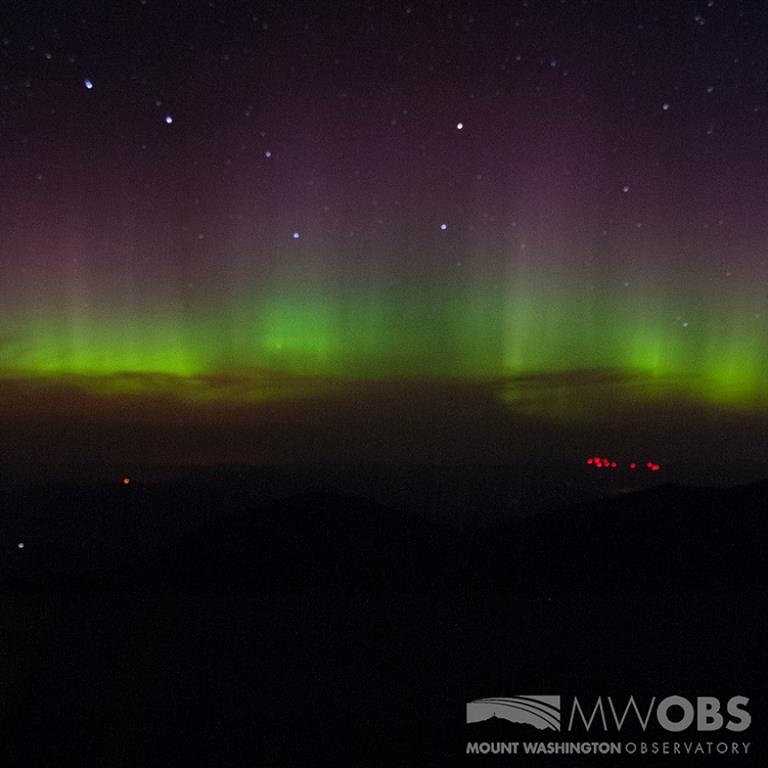The Science of Auroras
2018-08-08 06:18:51.000 – Christopher Hohman, Weather Observer/Staff Meteorologist
One of my personal favorite weather phenomenon here on the summit of Mount Washington, is one I haven’t actually observed yet! For the past few years I have been incredibly interested with quantum mechanics (A very fancy term that pretty much means the physics of how very small objects, like atoms and their electrons, move and/or interact!) in the atmosphere. A very beautiful phenomenon occurs at the atomic level that really interests me is the Aurora Borealis! In this blog I wanted to give just a brief explanation of how that works, and why there’s sadly a low chance we’ll see any this summer.
It starts with the sun. Highly energized particles are released from the sun, and are sent whizzing toward the earth at the speed of light. This energy takes about 8 minutes to hit the Earth (8 light minutes). These particles will first hit the Earth’s magnetic field. Some of it won’t actually reach the Earth’s atmosphere, but the rest of it is funneled toward the poles, and dumped into our atmosphere (Hence why we only see the Aurora at the poles!).
This is where the fun begins. Once that energy gets past the magnetic field, it is then absorbed by various gases in our atmosphere. These gases are typically Nitrogen, and Oxygen (The two most abundant gases in our atmosphere). When the energy is absorbed, it actually excites the electrons in the Oxygen and Nitrogen atoms. The electrons stay in the excited state briefly, then (to put in layman’s terms) un-excite themselves. When that happens, visible light waves are admitted by the atom. Or, as we like to call it, the Aurora!

I know I’m blasting you with physics right now, but there’s one last piece of this that really interests me. The Aurora normally only comes in Green or Red. Sometimes it’ll come in Blue or Violet, but that’s normally very hard to see. Why only these colors? This is due to the fact that Oxygen and Nitrogen can only absorb specific amounts of energy from the sun. Not too much, not too little, only specific amount to excite their electrons. Because of this, the atoms can only admit specific colors. Any other color you may see is just the colors blending together!
As I stated before the sun’s energy is where this whole process even starts. Right now we are heading into what’s called a solar minimum. I could have an entire blog post about what that is, but essentially it means the sun is not as active. Because of this the sun isn’t blasting us with bursts of high energy particles as often. So, unfortunately, it’s unlikely we’ll have a strong aurora to reach New England this summer.
Chin up though! There’s still plenty of awesome weather to observe in the meantime. I hope you enjoyed my blog, and even learned a few things from it! If you’re wondering how intense the Aurora will be tonight, just head on over to this website: http://www.aurora-service.org/aurora-forecast/
Christopher Hohman, Weather Observer/Staff Meteorologist
Team Flags Return for Seek the Peak’s 25th Anniversary
Team Flags Return for Seek the Peak's 25th Anniversary By MWOBS Staff Mount Washington Observatory is looking forward to continuing a much-loved tradition for Seek the Peak’s 25th Anniversary: Team flags. In inviting teams
Meet Summer Interns Zakiya, Max and Maddie
Meet Summer Interns Zakiya, Max and Maddie By MWOBS Staff We are excited to welcome six teammates to the summit of Mount Washington this summer! During their internship, these students and graduates will play
Saying Goodbye to the Summit
Saying Goodbye to the Summit By Alexis George After an extraordinary last three years working as a Weather Observer and Meteorologist, I am excited to pursue a different career. As sad I as am




